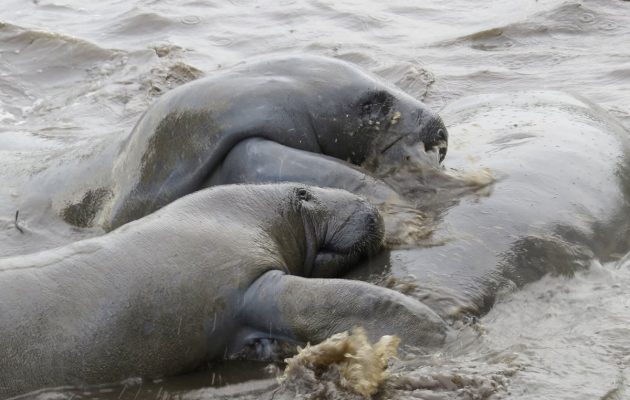On the Lookout for the St. Johns’ Gentle Giants

Editor’s Note: The Resident News encourages the next generation of bright, talented journalists and writers. We believe in helping give students the opportunity to learn from the industry and have their work published. This article was written by one of our own aspiring locals, Lucy Rachels, who will be starting her sophomore year at Auburn University in the fall.
Just under the surface of the St. Johns River, amidst the familiar algae and occasional gator, reside nature’s gentle giants – manatees, who have inhabited Florida for hundreds of years. These gentle, slow-moving creatures gracefully move about the St. Johns, capturing the attention of locals and visitors alike.
Manatee sightings in the St. Johns River are most common in the late spring or summer. During the remainder of the year – roughly November to March – manatees swim south to warmer water, often congregating in warm Florida springs. By early April, manatees begin to leave their winter homes and disperse themselves across Florida, hundreds of them returning to the St. Johns. However, the increased number of manatees during summer months lends itself to June having the highest number of manatee deaths due to boat strikes.
Boat collisions are the third-leading cause of death overall for manatees, behind natural fatalities and perinatal death, and is the leading cause of unnatural death. Manatees swim close to the surface and come up every 3-5 minutes to breathe, making them very easy to hit if boaters aren’t on the lookout. Additionally, manatees cannot hear the low-frequency sounds of boats, meaning they are unaware of the need to dive deeper when a boat approaches. In other words, they don’t know you are coming until they are hit.
However, manatee deaths can be easily avoided. There are many tricks for spotting manatees, such as keeping an eye out for “manatee footprints,” which are flat circles on the surface of the water, checking for bubbles rising to the surface and listening for water snorts.
According to Dr. Quinton White, a marine science specialist at Jacksonville University, it is also important to avoid feeding or giving fresh water to manatees.
“Such activities are not only illegal but encourage manatees to seek out humans for food and water, which in turn puts them in harm’s way,” said White.
Boaters should obey speed limits in protection zones and no-wake zones. Since manatees prefer to hang out in shallow water, the no-wake zones located throughout St. Johns are very important.
The good news is that watercraft deaths for manatees have been down in Duval County in recent years, with zero so far this year and only two in 2022. However, Florida manatee deaths overall are up, with 1,100 deaths in 2021 and over 800 in 2022. These have been the two worst years on record in the 2000s.
Another way to help save manatee lives is to reduce toxic runoff. This means cutting down on fertilizer use, not blowing grass cuttings onto the street and making sure storm drains receive only water.
“Homeowners can reduce polluted runoff to reduce the risk of harmful algae outbreaks toxic to manatees and conserve water to protect spring flow that is critical to manatees and river health,” said the St. Johns Riverkeeper’s Lisa Rinaman, who helps spread awareness about manatees and the St. Johns River.
Being mindful of plant pollution is vital to manatee life, as plants are the only things manatees eat; they have no natural predators or prey. Manatees often spend up to eight hours a day hunting for enough plants to sustain their huge bodies.
Manatees are protected by multiple pieces of legislation, including Florida state law: the Florida Manatee Sanctuary Act, which says that it is illegal to intentionally harm a manatee, and the Marine Mammal Protection Act, which further protects marine mammals and their habitats. Locally, in 2017, the Jacksonville Zoo created the first-ever Manatee Critical Care Center in the Northeast Florida region. Here, injured manatees are nursed to health and released back into safe waters.
Despite the many threats manatees face, there is still a clear path to their protection. By being vigilant in protective practices, we can enable manatees to thrive in the St. Johns River for years to come.
By Lucy Rachels
Resident Community News







